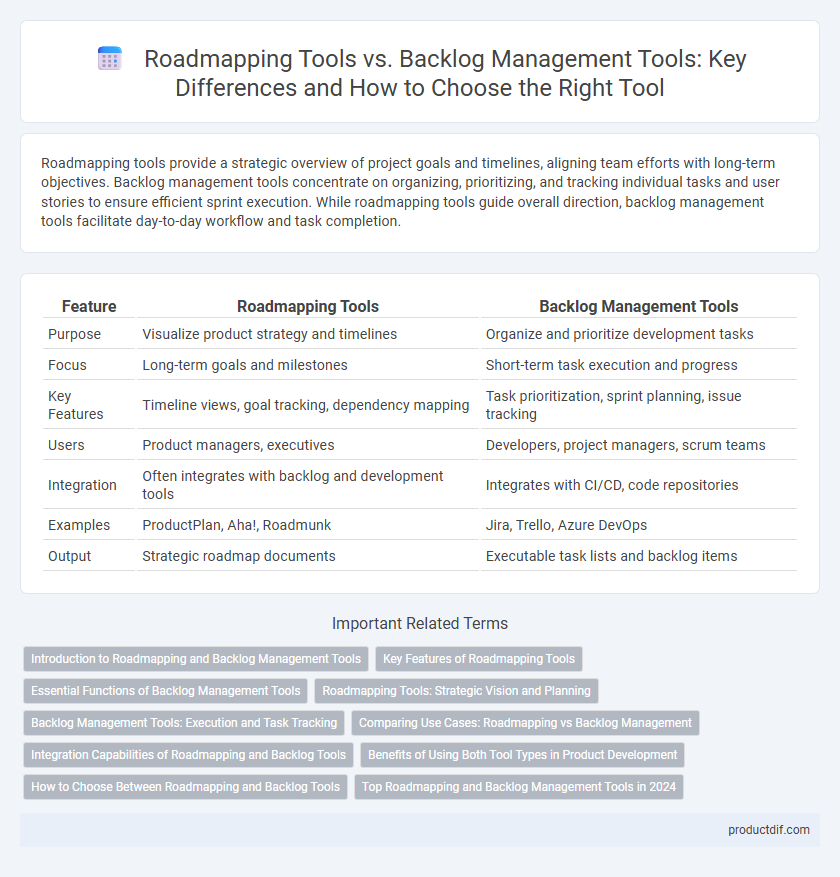Roadmapping tools provide a strategic overview of project goals and timelines, aligning team efforts with long-term objectives. Backlog management tools concentrate on organizing, prioritizing, and tracking individual tasks and user stories to ensure efficient sprint execution. While roadmapping tools guide overall direction, backlog management tools facilitate day-to-day workflow and task completion.
Table of Comparison
| Feature | Roadmapping Tools | Backlog Management Tools |
|---|---|---|
| Purpose | Visualize product strategy and timelines | Organize and prioritize development tasks |
| Focus | Long-term goals and milestones | Short-term task execution and progress |
| Key Features | Timeline views, goal tracking, dependency mapping | Task prioritization, sprint planning, issue tracking |
| Users | Product managers, executives | Developers, project managers, scrum teams |
| Integration | Often integrates with backlog and development tools | Integrates with CI/CD, code repositories |
| Examples | ProductPlan, Aha!, Roadmunk | Jira, Trello, Azure DevOps |
| Output | Strategic roadmap documents | Executable task lists and backlog items |
Introduction to Roadmapping and Backlog Management Tools
Roadmapping tools provide a high-level visualization of product strategy, aligning team goals and timelines to drive long-term planning and prioritization. Backlog management tools focus on organizing and tracking detailed tasks, user stories, and bug fixes to ensure efficient sprint execution and iterative development. Both tools integrate to enhance Agile workflows, improving transparency and collaboration across product and engineering teams.
Key Features of Roadmapping Tools
Roadmapping tools provide a visual timeline for strategic planning, enabling teams to outline product goals and milestones with clear dependencies and progress tracking. They support scenario planning and stakeholder alignment through customizable views and real-time collaboration features. Unlike backlog management tools, roadmapping tools emphasize high-level prioritization and long-term vision rather than detailed task management.
Essential Functions of Backlog Management Tools
Backlog management tools are essential for prioritizing tasks, tracking progress, and ensuring clear communication across development teams. These tools enable efficient issue tracking, sprint planning, and real-time collaboration, which streamline workflow and enhance productivity. Compared to roadmapping tools, backlog management solutions focus specifically on managing work items at a granular level, providing features like customizable boards, status updates, and integration with version control systems.
Roadmapping Tools: Strategic Vision and Planning
Roadmapping tools enable organizations to visualize strategic goals and align project timelines with long-term business objectives, enhancing decision-making and resource allocation. These tools prioritize high-level planning by mapping out product evolution, market trends, and stakeholder priorities, ensuring clarity and direction throughout the development lifecycle. By contrast, backlog management tools focus primarily on task-level organization, lacking the comprehensive strategic vision that roadmapping tools provide.
Backlog Management Tools: Execution and Task Tracking
Backlog management tools excel in execution and task tracking by providing real-time visibility into project progress, prioritizing work items, and facilitating agile workflows. These tools enable teams to break down tasks, assign responsibilities, and monitor deadlines, ensuring efficient sprint planning and delivery. Integration with version control and communication platforms enhances collaboration and accelerates issue resolution during software development cycles.
Comparing Use Cases: Roadmapping vs Backlog Management
Roadmapping tools excel at strategic planning by visualizing project milestones, timelines, and long-term goals, enabling teams to align on vision and priorities. Backlog management tools focus on task organization, prioritization, and workflow tracking to streamline day-to-day development and issue resolution. Comparing use cases, roadmapping tools guide high-level decision-making and product evolution, while backlog management tools ensure efficient execution and continuous delivery.
Integration Capabilities of Roadmapping and Backlog Tools
Roadmapping tools offer advanced integration capabilities with backlog management systems, enabling seamless synchronization of strategic plans and execution tasks. These integrations facilitate real-time updates, ensuring that backlog items align with overall product goals and timelines. Enhanced connectivity between roadmapping and backlog tools supports cross-functional collaboration and improves workflow transparency.
Benefits of Using Both Tool Types in Product Development
Roadmapping tools provide a strategic overview of product goals and timelines, while backlog management tools focus on task prioritization and sprint planning. Integrating both tools enhances communication between teams, ensures alignment on long-term objectives, and improves workflow efficiency. Using roadmapping and backlog management tools together supports agile development by balancing high-level vision with detailed execution.
How to Choose Between Roadmapping and Backlog Tools
Choosing between roadmapping tools and backlog management tools depends on project scope and team workflow. Roadmapping tools provide a strategic overview, allowing stakeholders to visualize long-term goals and timelines, while backlog management tools focus on organizing and prioritizing tasks in agile development cycles. Evaluating whether your primary need is for high-level planning or detailed task execution guides the optimal tool selection.
Top Roadmapping and Backlog Management Tools in 2024
Top roadmapping tools in 2024, such as Aha!, ProductPlan, and Roadmunk, excel in visualizing product strategy, aligning team goals, and managing timelines with customizable dashboards. Leading backlog management tools like Jira, Azure DevOps, and ClickUp prioritize task tracking, sprint planning, and issue resolution, offering advanced integration with development workflows and real-time collaboration features. Choosing between roadmapping and backlog management tools depends on whether the focus is strategic planning or detailed task execution within agile environments.
Roadmapping tools vs Backlog management tools Infographic

 productdif.com
productdif.com